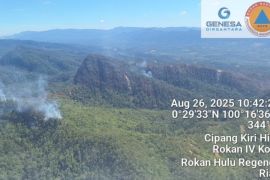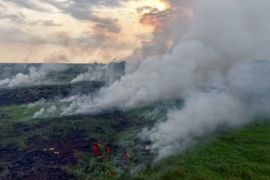Human beings and animals have been suffering the most, as forests on the islands of Sumatra and Kalimantan are home to varied floral and faunal species, including endangered animals, such as the Sumatran tigers, Sumatran elephants, and orangutans.
Several of those animals abandoned their habitat to escape the fires. In Central Kalimantan, tens of orangutans (Pongo pygmaeus) contracted respiratory ailments.
In Riau, a Sumatran tiger was found roaming near an oil facility in early August, as the wild animal attempted to flee the forest fire that had destroyed its habitat.
Moreover, Sumatran elephants fled their habitats, entering residential areas after wildfires spread through the Tesso Nilo National Park in Riau Province.
When wildfires ravaged through the national park for the past week, dozens of elephants fled to residential areas in search of food at plantations.
Related news: Wildfires in Riau force wild elephants to flee habitats
Related news: Tesso Nilo's elephants show signs of stress due to forest fire
The national park's rangers had monitored the movement of wild Sumatran elephants (Elephas maximus sumatranus) from the rainforest to Bongkal Malang Village in Indragiri Hulu District, Andi Hansen Siregar, head of the the Riau Natural Resources Conservation Office (BBKSDA), stated recently.
Two elephants were spotted roaming around plantation areas in Bongkal Malang for several days. An initial identification launched by the rangers indicated that one of the wild animals was an adult male Sumatran elephant that had allegedly damaged a palm plantation.
In Cirenti Sub-district, Kuantan Singingi District, three wild elephants were spotted roaming around residential areas, and the local rangers had managed to drive away the elephants.
In early October 2019, a human-elephant conflict raged in the areas of Bener Meriah District, Aceh Province, with a herd of wild Sumatran elephants destroying four houses in Pantanlah Village, Pintu Rime Gayo Sub-district. Although no deaths were reported in the incident, the elephants had damaged the local farmers’ fields.
The elephants repeatedly wandered into villages in the sub-district in search of food.
"Hence, the villagers have been urged to remain vigilant and cautious with this ongoing human-elephant conflict to avoid fatalities," Putra, a local official, stated.
Several packages of staple food and clothing had been distributed to ease the burden of villagers, whose houses were destroyed by the wild elephants, Secretary of Bener Meriah District Administration's Social Affairs Office Saidi Nurdin stated.
Bener Meriah, one of the districts in Aceh Province, is vulnerable to the impact of human-elephant conflicts.
In February, a herd of wild Sumatran elephants had gone on a rampage in Negeri Antara Village, Pintu Rimbee Sub-district. The giant animals not only ravaged the agricultural lands but also attacked and injured a 40-year-old trained elephant named Ida.
In June 2019, a herd of 12 elephants ran amok in the villages of Blang Lango and Tuwi Meuleusong in Seunagan Timur Sub-district, Nagan Raya District, Aceh Province.
Related news: Wild elephants destroy four houses in Aceh
The World Wildlife Fund (WWF) recently drew attention to the critical condition of eight enclaves of the Sumatran elephant that may result in the species' extinction following changes in nature that have fueled conflict with humans.
"Several elephant enclaves have been transformed into palm oil plantations and industrial forest areas, thereby sparking greater conflicts with humans," Syamsidar, a spokesman of the WWF Riau Program, stated on June 14, 2019.
According to a survey by WWF, the elephant population in some enclaves had dwindled and could possibly result in local extinction. Syamsidar remarked that only one elephant remained in each enclave in Rokan Hilir and Batang Ulak, whereas only three elephants were alive in Mahato-Barumun, while the Balai Raja enclave was home to only eight elephants.
"In Mahato, all three elephants are females. There is no possibility of reproduction, and this can lead to what we call as local extinction," he cautioned.
However, 50-60 Sumatran elephants remain in the Giam Siak Kecil enclave, while 30-38 elephants in North Tesso Nilo, and 50-60 elephants in Southeast Tesso Nilo.
In the meantime, one of the elephants at the Balai Raja Wildlife Conservation area in Riau died on Oct 7, 2019. The female elephant called Dita severely wounded her left leg after being trapped in a poacher's snare in 2014.
In spite of the authority's all-out efforts to heal Dita, the elephant succumbed to her wound and was found dead in a puddle. Dita's corpse was only found five days after her death.
Parts of the area, where 25-year-old Dita was found dead within the conservation area, has been changed to make way for housing, government offices, and palm oil plantations.
Habitat loss has forced the elephants to enter the palm oil plantation, and the local residents view the species as a pest.
Lately, rains have begun to fall on Sumatra and Kalimantan Islands as parts of Indonesia's regions are entering rainy season since October this year.
Related news: Balai Raja conservation area's Sumatran elephant population dwindles
Editor: Sri Haryati
Copyright © ANTARA 2019











